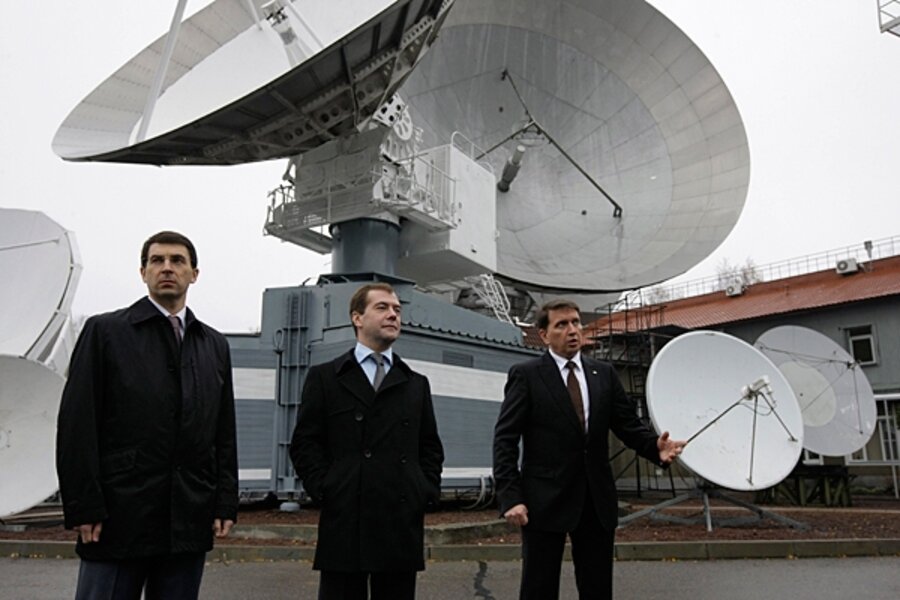Russians to ride a nuclear-powered spacecraft to Mars
Loading...
MOSCOW – A nuclear-powered spaceship that can carry passengers to Mars and beyond may sound like science fiction.
But Russian engineers say they have a breakthrough design for such a craft, which could leapfrog them way ahead in the international race to build a manned spacecraft that can cover vast interplanetary distances.
They claim they’ll be ready to build one as early as 2012.
In a meeting with top Russian space scientists Wednesday, President Dmitry Medvedev gave the nuke-powered space craft a green light and pledged to come up with the cash to cover its $600-million price tag.
“It’s a very serious project, and we need to find the money,” Mr. Medvedev told the scientists.
Small nuclear reactors and atomic batteries have long been used to power unmanned spy satellites, and both NASA and the former Soviet space program spent huge sums trying to design a safe system that could propel a spacecraft once it left the Earth’s atmosphere (see Project Orion and Project Prometheus), analogous to the way nuclear-powered submarines operate.
Most manned spacecraft are propelled by chemical rockets, and supplement their energy needs with solar panels. But experts say existing rocket technology would be impractical for long-distance flights, even for a voyage to our nearest planetary neighbor, Mars.
“The energy requirements for a three-year flight is very great, and that calls for a technology that can deliver a lot of power,” says Andrei Ionin, an independent Moscow-based space expert.
“The former USSR had a lot of accumulated experience in this field,” lofting scores of nuclear-spy satellites over three decades, he says.
“The idea (of nuclear-powered spaceflight) has bright prospects, and if Russia could stage a breakthrough it could become our main contribution to any future international program of deep space exploration,” Mr. Ionin adds.
Russia’s space program has recovered from its post-Soviet slump but still has not succeeded in launching any major independent projects and remains a space-going taxicab for other nations and tour operator for wealthy thrill-seekers (such as Cirque du Soleil founder Guy Laliberte) willing to pay for a brief stay on the International Space Station.
Russian scientists complain that their post-Soviet space program is chronically underfunded. But when a project is endorsed by top leadership (the Sochi 2014 Olympics, for example), recent history indicates the funding is likely to be found.
A breakthrough in atomic-powered propulsion would loft Russia back into the front ranks of space-faring nations and make it the indispensable partner for future international space efforts. And with the US forging ahead with its own next-generation replacement for the space shuttle, the Ares 1-X (launched Wednesday), Russia could use a public relations victory in this realm.
But critics say the idea of nuclear-powered space travel, while alluring, is probably impracticable.
“Nobody has ever done it in the past, and I don’t think anyone ever will,” says Igor Lisov, an expert with Novosti Kosmonavtiki, a leading Russian aerospace journal.
“Both the US and the USSR tried very hard to master this technology, but neither ever got to the point of building something that could be used,” he says.
Environmentalists point to a long list of accidents with Soviet nuclear-powered satellites, including the crash of Kosmos-954 over northern Canada, which spread radioactive debris over a wide area.
Earlier this year, a US Iridium communications satellite collided in space with another Russian atomic-powered military satellite, Kosmos 2251, creating what scientists described as a huge and potentially hazardous cloud of debris in near-Earth orbit.
“The main danger with any nuclear activity in space comes with the transporting of these materials into orbit, and the sometimes unscripted return of them into the atmosphere,” says Vladimir Chuprov, an energy expert with Greenpeace-Russia.
“There is a history here that warns us to be very, very cautious about this idea,” he says.
Is space exploration too expensive for one nation? Click here to read about efforts to create an international Starfleet Command.





